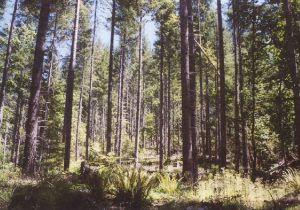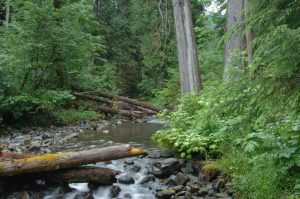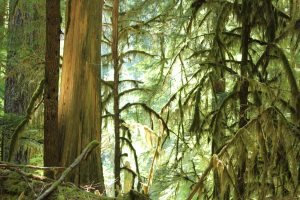Section I
What do you expect to observe when we visit the H.J Andrews?
I anticipate to see the Lookout Creek Watershed within the Willamette National Forest, the long-lived conifers, associated wildlife and stream ecosystems, first-hand data collection and analysis, and the four Reflection plots.
What are some of the different ways of telling the story of these forests? How do these methods of creative reflection support scientific inquiry and vice-versa?
There are several ways of telling the story of forests. They include both scientific and artistic methods such as through poetry, observation and experiment, and through myths and math. Creative use of language, concepts and metaphors shape what scientists can see and imagine thus enabling them ask novel questions, propose innovative solutions thus better communicating their ideas that can become part of peoples’ lives. Creative writers on the other hand, draw on the rich vocabulary and conceptual insights of science to help people understand the value of the world and feel a visceral connection to an issue to act upon it.
Why is the long-view critical to understanding the role of humans in the natural world?
Comprehending the long-view is significant due to the dynamic nature of both societal and environmental contexts regarding the role of humans in the natural world. Because of this, there is need for humans to imagine and enact strategies that will help ensure the continuity of environmental systems, by cultivating a community of interest in people, and committing to have faith in the future of these systems.
Section II
Why was this theme chosen (e.g., Research and Revelation for Part One) to tell the story of the H.J. Andrews Experimental Forest?
Research and Revelation
The writer chose this title as part one probes an inquiry into the nature of the old growth forest from the out view, decomposition and human-ecological interactions. This section also reveals a lot about the nature of the landscape and the need for humans to adopt the long-view so as to understand their role in ecological systems.
Change and Continuity
The writer chose this title to illuminate the changing relationship between the forest and human culture. This has resulted in the change in the nature of forests from species’ evolution and co-evolution, vegetation succession and extinction of certain species. The continuity describes nature’s response after disturbances from vegetation succession to restorative land forms.
Borrowing Others’ Eyes
The writer chose this title to emphasize the need for us to learn from other people’s experiences. This is because humans have the tendency to perceive acute changes relatively quickly, while overlooking small gradual changes that may have a significant effect on ecosystems.
What do you expect the landscape to look like from the passages in this section?
Research and Revelation
The landscape has a high elevation ranging between 1300 to 5300 feet. The lower rocks are volcanic composed of lava flows and mud flows. Conifers dominate the old growth though other species such as Douglas fir, wet and dry meadows, herbs, shrubs and deciduous trees exist. There are also several streams crisscrossing the landscape.
Change and Continuity
The landscape has suffered the effects of disturbances such as floods, landslides and wildfires. There are new stream channels formed from the rearrangement of previous stream channels. There are also clear-cuts and sections containing post disturbance vegetation such as shrubs and herbs. Present also are dead decaying logs.
Borrowing Others’ Eyes
The landscape is characterized by dense growth. There is plenty of water resulting in pervasive dampness and excessive humidity. There are soggy mats of moss draping tree limbs, and fungi and algae on the forest floor. There are also geophonics of small and large streams.
Provide an example or two of how the scientific context presented in the Ground work essay is reflected in creative storytelling for the section.
Research and Revelation
Log trucks full of ancient trees were barreling down the valley at a rate of one per minute. This depicts the excessive deforestation of the old growth.
Change and Continuity
Big wads of logs cruised down Lookout Creek. This shows the extent of flooding as an ecological disturbance in the forest.
Borrowing Others’ Eyes
If you walk hard wearing rain gear, you’re drenched with sweat from the inside, and a trickle bisects your shoulder blade. This shows intense humidity that characterizes the outgrowth.
What’s a question you have about the forest from reading these passages? How can we use science and art to enlighten the community on the need to preserve forests?
References:
https://www.google.com/search?q=hj+andrews+experimental+forest&espv=2&biw=1366&bih=667&source=lnms&tbm=isch&sa=X&ved=0ahUKEwiZx9eLxtXOAhWmJMAKHd9RC78Q_AUIBygC#imgrc=_
https://www.google.com/search?q=hj+andrews+experimental+forest&espv=2&biw=1366&bih=667&source=lnms&tbm=isch&sa=X&ved=0ahUKEwiZx9eLxtXOAhWmJMAKHd9RC78Q_AUIBygC#tbm=isch&q=tree+stumps+at+hj+andrews&imgdii=t-BQ56SGo2Ph4M%3A%3Bt-BQ56SGo2Ph4M%3A%3Btk3ELmfIt9ajfM%3A&imgrc=t-BQ56SGo2Ph4M%3A



